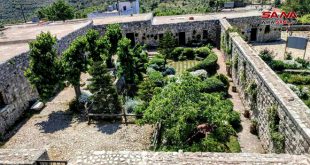
Tartous (ST): A visitor to the Museum of fighter Sheikh Saleh Al-Ali in the city of Sheikh Badr in the Tartous countryside stands in front of the beauty of nature and the simplicity and richness of the place, especially as it displays historical documents and equipment used by Al-Ali and his colleagues in their struggle against the French colonizer.
The museum, which was the home of the Sheikh Saleh Al-Ali, is a distinctive model of Syrian architecture and embraces in its halls a long history of the Syrian struggle.
The museum’s halls and green squares are full of visitors at all times, but the movement in it increases dramatically during the summer, and its visitors come from all segments and ages and from different areas of Tartous and other governorates.
Every visitor to the museum is a visitor to the tomb of Sheikh Saleh al-Ali, which is a symbol of the great Syrian revolution in 1925 according to the museum director, Tammam Merhej, who explained that the square surrounding the museum is also the seat of festivals and official events in the region, the most important of which is the annual festival that is held every year in memory of Independence Day.
The museum displays everything related to Sheikh al-Ali and the men of the revolution against the French occupation, where Merhej explained that it consists of 7 halls, the first hall was designated to receive visitors and get tickets. There is a hall containing documents and pictures indicating the lineage of Sheikh al-Ali and the folk songs that the people used to sing to motivate the revolutionaries.
Another hall is an old rural house dating back to the historical period in which Sheikh Saleh Al-Ali lived, and it includes samples of the tools that were used in that period.
K.Q.

